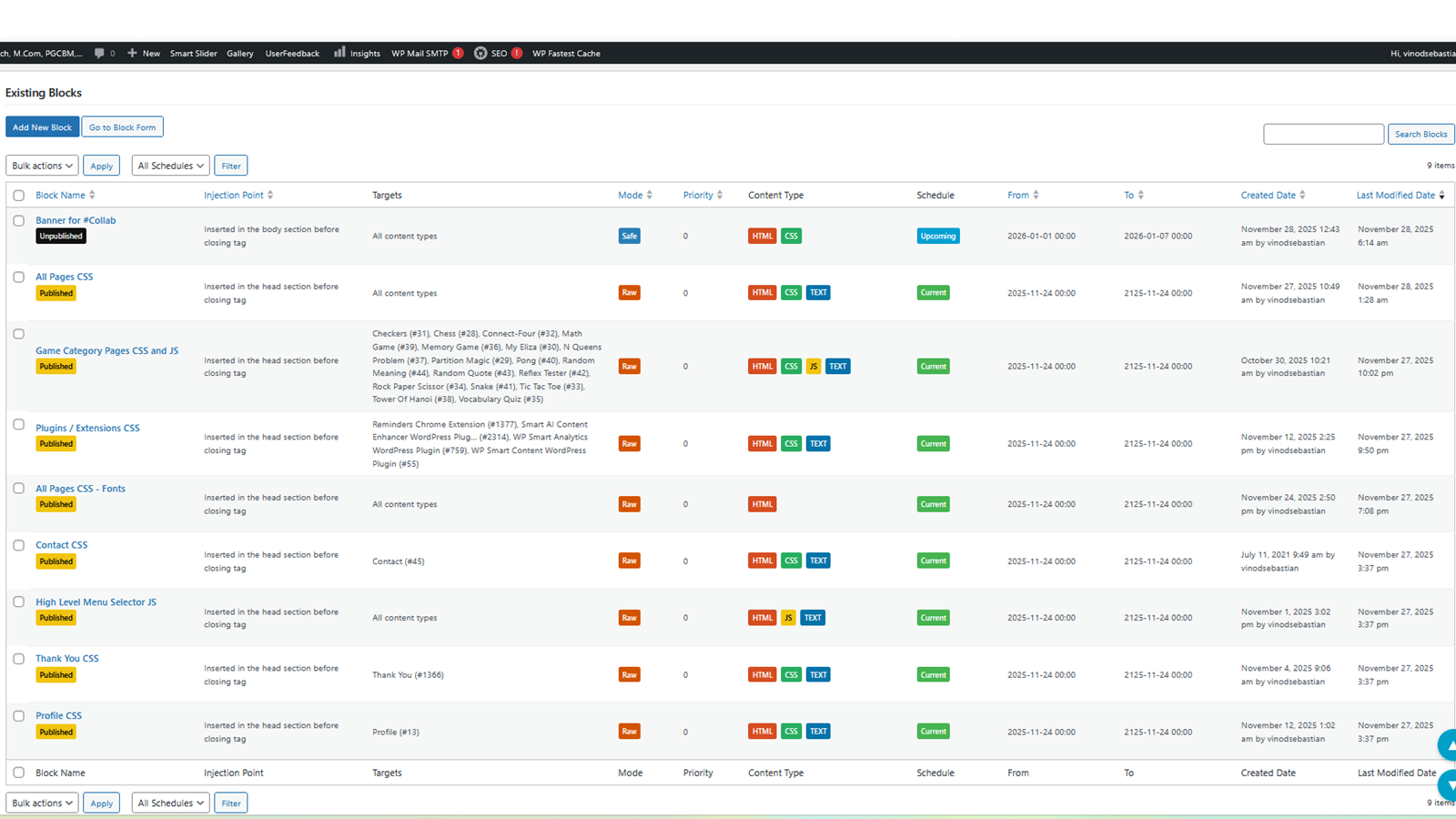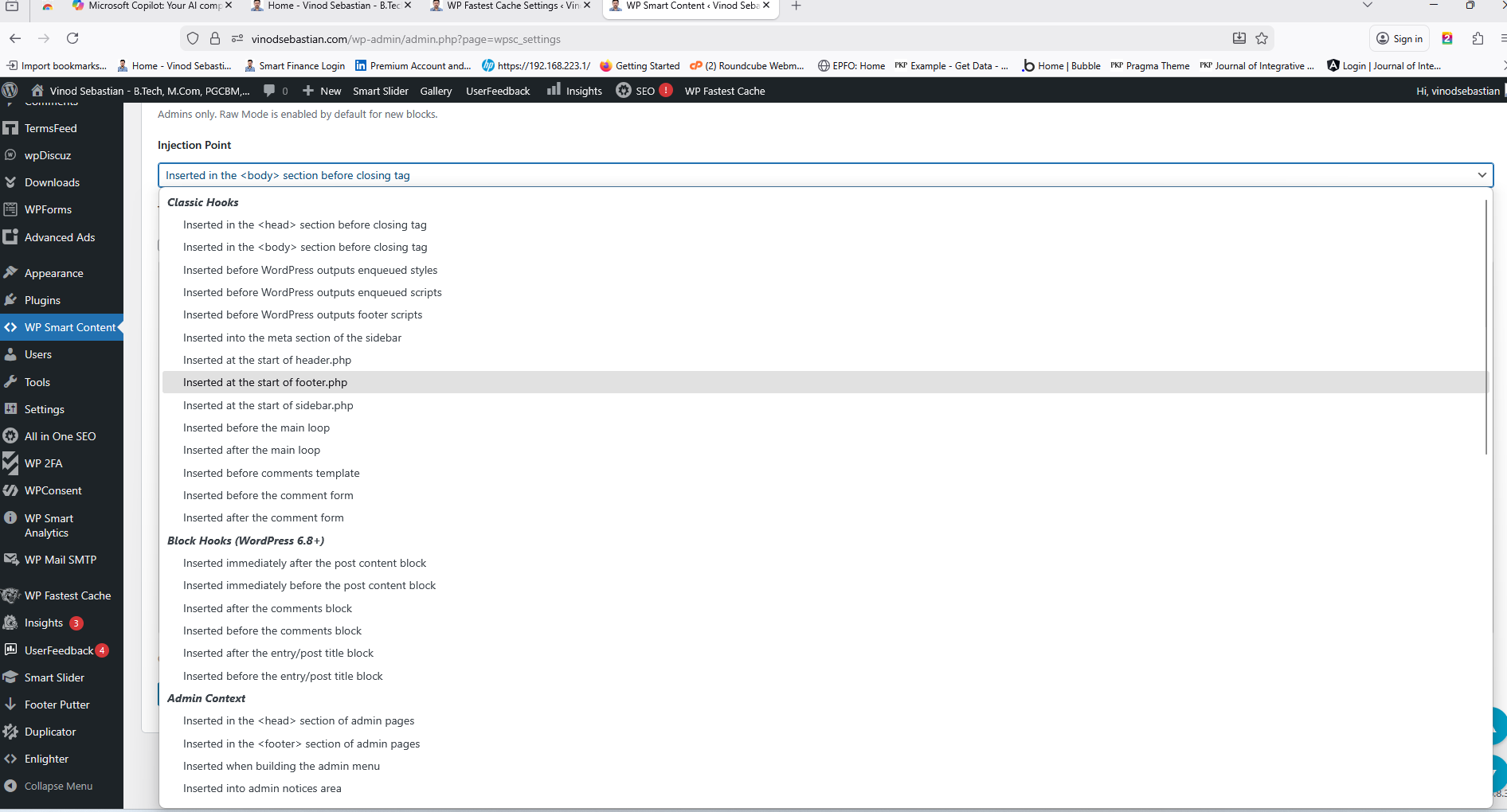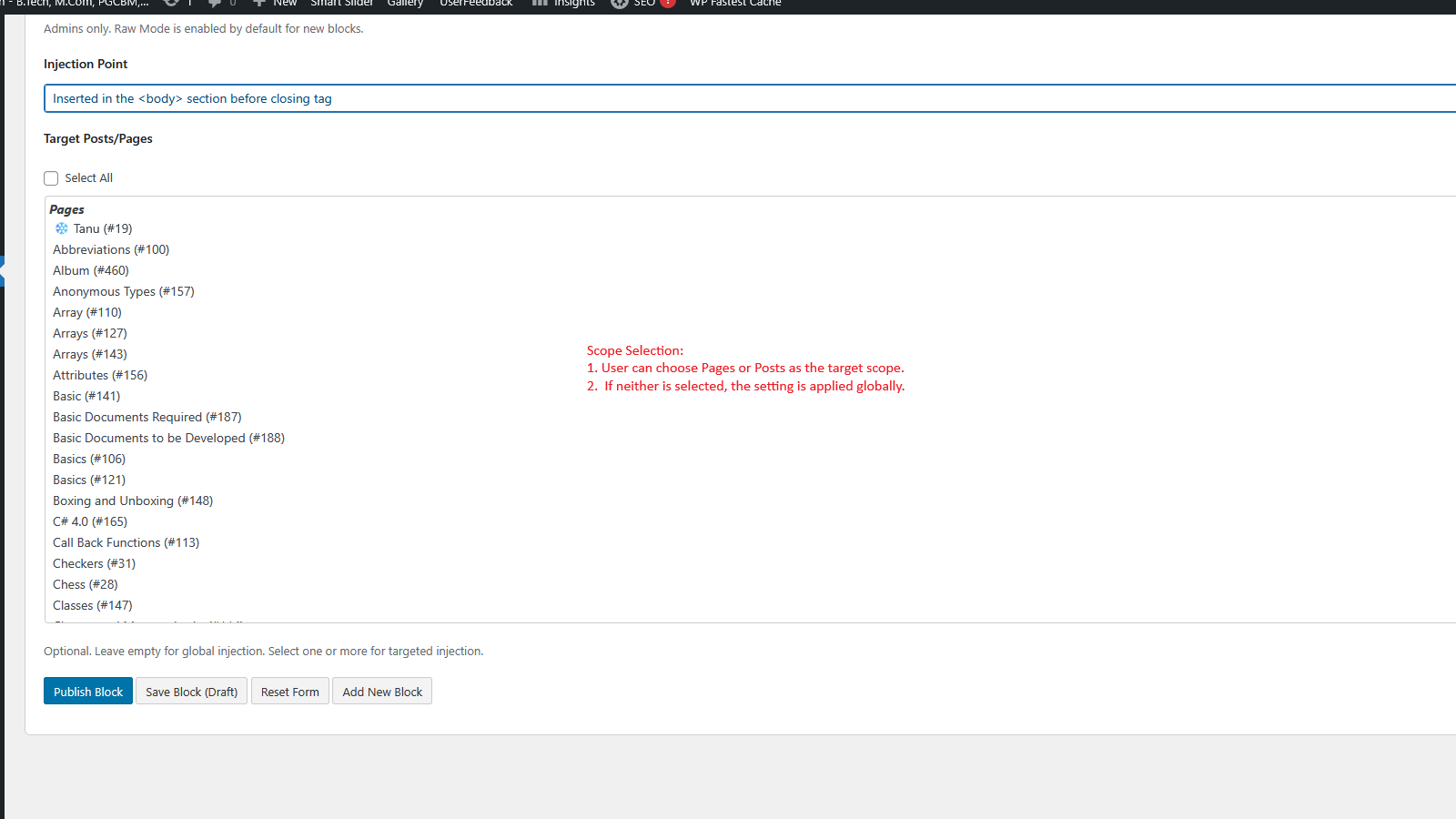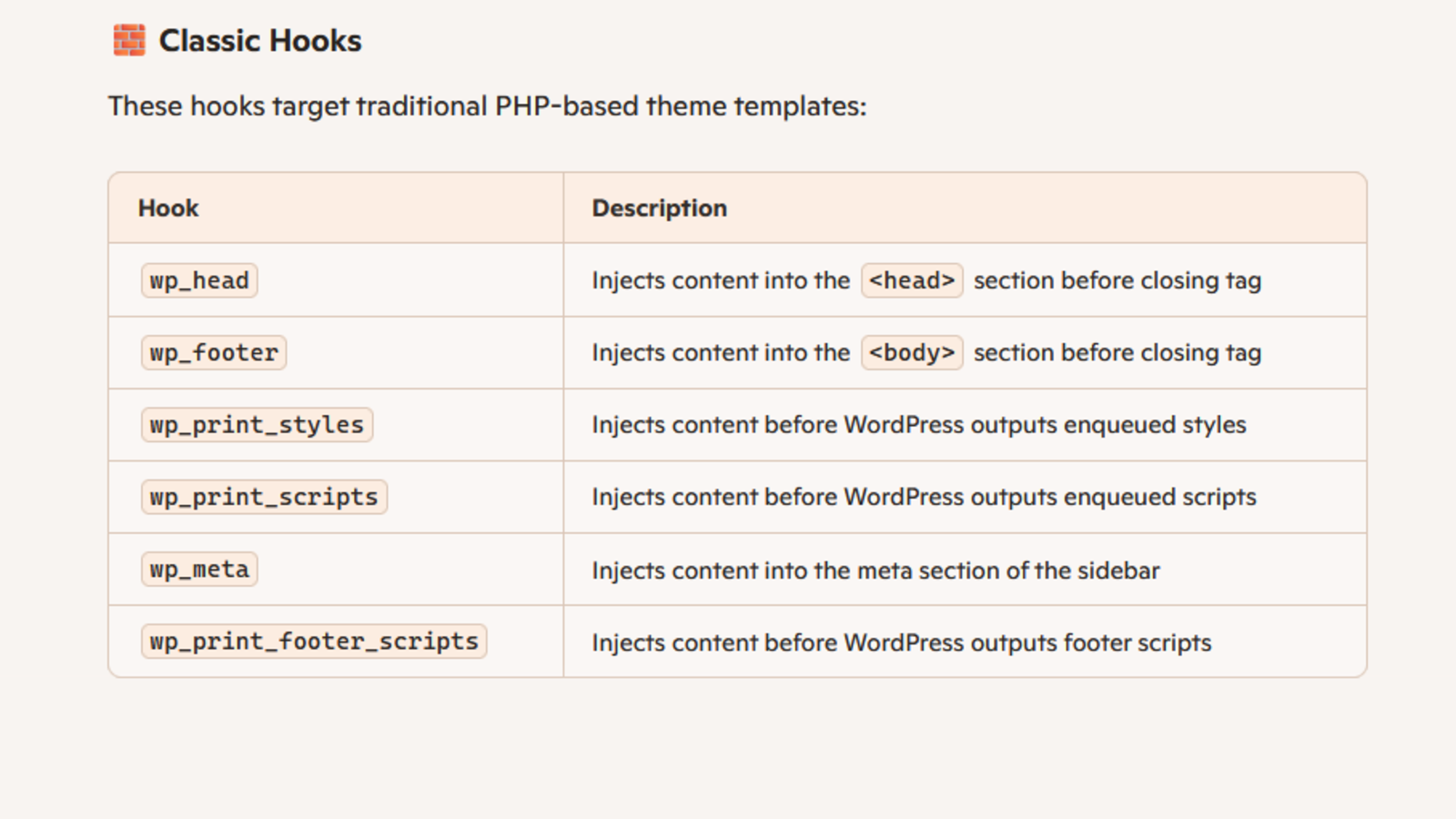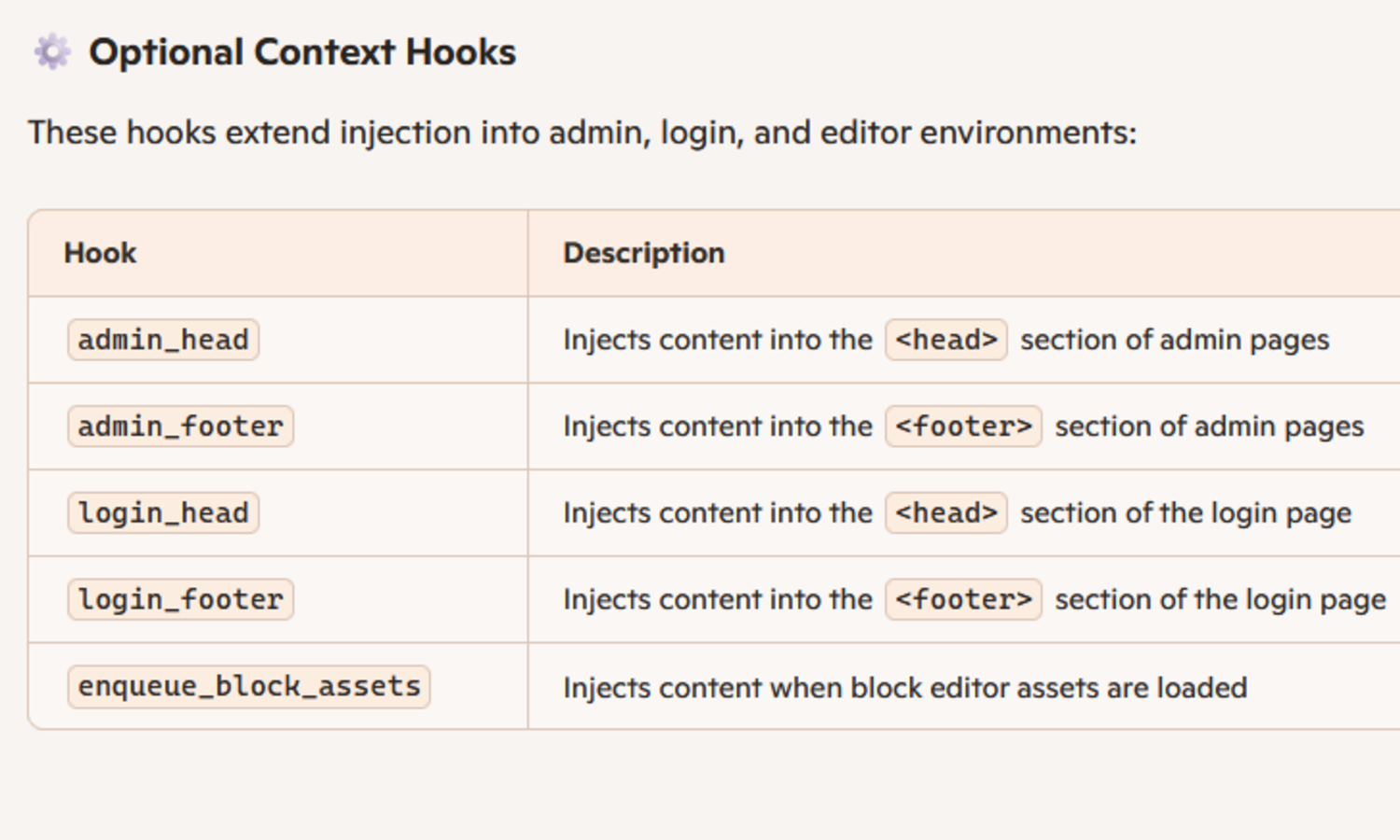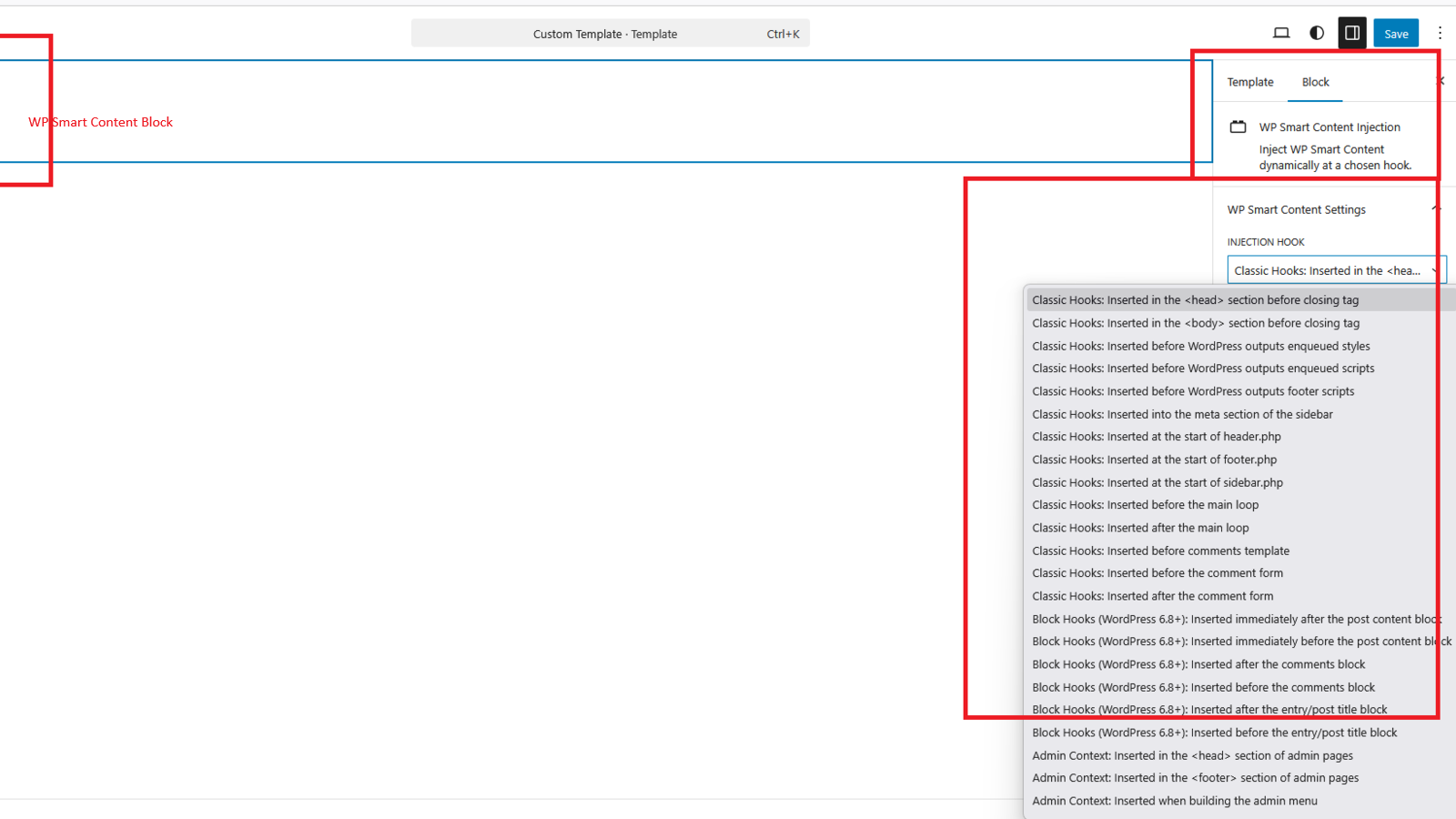WP Smart Content WordPress Plugin

Basic Information
WordPress Extension Link:
Contributors: vinodsebastian
Version: 1.2.15
Description
Inject scripts, styles, HTML, CSS, or tracking code into WordPress headers, footers, sidebars, block hooks, and shortcode locations — without editing templates. Supports classic PHP hooks, WordPress 6.8 Block Hooks, reusable snippets, and scheduling.
⏱ Schedule when you want
Every Smart Content block can be named, prioritized, scheduled, and stored safely in the WordPress database. Target blocks to specific posts or pages, or apply them globally across your site. Define start and end dates so snippets appear only when needed — ideal for campaigns, seasonal banners, or compliance notices.
📍 Publish where you want
Behind the scenes, WP Smart Content injects your HTML, JavaScript, or CSS styles into the selected WordPress hook — whether a classic theme hook or a modern Block Hook. Your content appears exactly where you want it, only for the time you want it, without modifying templates. You can also embed Smart Content blocks directly inside posts, pages, or widgets using a shortcode. This keeps your site secure, SEO-friendly, and easy to maintain.
🔒 Manage safely by whom you want
Administrators have full control with access to both **Raw Mode** (unfiltered output) and **Safe Mode** (sanitized injection). Trusted non-administrators can be granted limited access to pre-created blocks in Safe Mode by assigning the ‘wpsc_admin’ capability to their role, either through a role editor plugin or custom code. This makes it easy to delegate tasks securely — for example, handing over CSS styling to a designer without exposing broader site settings or sensitive scripts.
✅ Why WP Smart Content?
By combining flexible scheduling, precise hook targeting, and role-based permissions, WP Smart Content ensures snippets are placed exactly where and when you want them — and managed safely by the right people. It’s a compliance-ready, SEO-friendly solution that keeps your WordPress site secure, scalable, and easy to maintain.
✨ Key Features
- Classic Hooks support: Add content to wp_head, wp_footer, wp_print_styles, wp_print_scripts, wp_meta, and wp_print_footer_scripts.
- Block Hooks support (WordPress 6.8+): Inject content anywhere in the theme using the block editor UI.
- Grouped dropdowns: Clear separation between Classic Hooks and Block Hooks in the admin interface.
- Global targeting: Apply blocks to all content types, not just posts or pages.
- Scheduling support: Define start and end dates so snippets appear only when needed.
- Safe/Raw Mode toggle: Admins can enable Raw Mode for advanced HTML/JS injection or restrict to Safe Mode for safety.
- Role-based access: Grant trusted non-admins Safe Mode editing rights via the
wpsc_admincapability. - Translation ready: Includes updated .pot file with all strings for localization.
- Reviewer-friendly architecture: Modularized code, clear documentation, and compliance with WordPress coding standards.
💡 Use Cases
- Add a script to the <head> section without editing theme files.
- Insert HTML into the <footer> for custom notices or widgets.
- Push CSS before WordPress outputs styles for precise control.
- Inject a notice after post content using Block Hooks.
- Manage analytics or marketing tags centrally, without touching templates.
- Schedule snippets to run only during campaigns or seasonal events.
- Delegate Safe Mode CSS editing to a designer or contributor without exposing Raw Mode or sensitive site access.
Hooks
WP Smart Content provides several hooks for developers to extend or customize behavior:
Classic Hooks
- wp_head – Injects content into the <head> section before closing tag
- wp_footer – Injects content into the <body> section before closing tag
- wp_print_styles – Injects content before WordPress outputs enqueued styles
- wp_print_scripts – Injects content before WordPress outputs enqueued scripts
- wp_meta – Injects content into the meta section of the sidebar
- wp_print_footer_scripts – Injects content before WordPress outputs footer scripts
Block Hooks (WordPress 6.8+)
- after_post_content – Injects content immediately after the post content block
- before_post_content – Injects content immediately before the post content block
- after_comments – Injects content after the comments block
- before_comments – Injects content before the comments block
- after_entry_title – Injects content after the entry/post title block
- before_entry_title – Injects content before the entry/post title block
Optional Context Hooks
- admin_head – Injects content into the <head> section of admin pages
- admin_footer – Injects content into the <footer> section of admin pages
- login_head – Injects content into the <head> section of the login page
- login_footer – Injects content into the <footer> section of the login page
- enqueue_block_assets – Injects content when block editor assets are loaded
Usage
Administrators have access to both Raw and Safe modes. Trusted non‑administrators can be granted access to pre‑created blocks in Safe mode by assigning the `wpsc_admin` capability to their role, either through a role editor plugin or via custom code.
Usage with Block Snippet
- Install and activate WP Smart Content from the WordPress Plugins screen.
- Go to WP Smart Content → Add New Block in the admin menu.
- Enter a block name and paste your HTML, CSS, JavaScript, or tracking code.
- Choose where to inject the block:
- Header (wp_head) for scripts or tracking code
- Footer (wp_footer) for notices or widgets
- Before/after post content for banners or messages
- Block Hooks (WordPress 6.8+) for precise placement in the block editor
- Other classic hooks such as wp_print_scripts or wp_meta
- Select targeting options:
- Apply globally across the site
- Restrict to specific posts, pages, or custom post types
- Set priority to control execution order when multiple blocks use the same hook.
- Define scheduling by assigning start and end dates so snippets appear only when needed.
- Save the block. Your content will be automatically injected at the chosen location.
- Use the Safe/Raw Mode toggle:
- Safe Mode: Restricts advanced HTML/JS in blocks for security
- Raw Mode: Allows full HTML/JS in blocks for trusted admins
- Manage all blocks from the central dashboard. You can edit, enable/disable, publish/unpublish, or delete blocks anytime.
Usage with Block UI
- Once WP Smart Content is activated, open the Site Editor (Appearance → Editor) for your block theme.
- Locate Block Hook areas (header, footer, before/after post content, sidebar).
- From the block inserter (+), add the “WP Smart Content” block or select an existing block to edit its injection hook.
- Use WP Smart Content settings in the right sidebar (Block tab) to select an injection hook. This links your stored block snippet to the chosen hook.
- Save the template. Your snippet will be injected automatically at the chosen location.
- Result: Scripts, styles, or HTML are added via the Block UI without editing theme files, fully compatible with block themes.
Usage with Shortcodes
- Place the shortcode directly in your post, page, or widget:
[wp_smart_content name="blockname"] - Replace “blockname” with the name of your Smart Content block.
- The shortcode will:
- Inject the block inline at the exact position where the shortcode is placed.
- Respect publish status (only published blocks are shown).
- Respect scheduling (start/end dates defined in block).
- Example:
[wp_smart_content name="header-banner"]
→ This will display the “Header Banner” block inline inside your post/page content. - Please note:
- Preferred Injection Point: When configuring the block, it is recommended to select “Placeholder for shortcode” as the injection point. This ensures the block does not render against any other hook.
- Independence from Target Post/Pages: Shortcode injection is not dependent on the Target Post/Pages multiselect. The block will display wherever the shortcode is placed, regardless of targeting settings.
Installation
- Upload ‘wp-smart-content’ to the ‘/wp-content/plugins/’ directory.
- Activate the plugin through the *Plugins* menu in WordPress.
- A new top‑level menu called *WP Smart Content* appears in the WordPress admin sidebar.
Frequently Asked Questions
Q. Why doesn’t my header script show up?
A. The template may not support the chosen hook. Don’t worry — it won’t break your site.
Q. My site broke after installation!
A. Unpublish or delete the content pushed through the plugin. Ensure the content added is valid HTML, CSS, or JavaScript.
Q. I still have plugin conflicts or the site looks messy.
A. Try selectively disabling other plugins to identify conflicts.
Q. How do I uninstall the plugin?
A. Just uninstall it. No residual data or issues will remain.
More questions? Email business[at]vinodsebastian.com — I’ll try to respond promptly.
Screens
- Administration screen – Block List (shows all reusable blocks with pagination)
- Administration screen – Block Form (create/edit block with Safe/Raw toggle)
- Grouped injection points dropdown (Classic vs Block Hooks clearly separated)
- Example of Raw Mode toggle in block editor
- Block Hooks injection after post content
- Classic Hooks reference
- Block Hooks reference (WordPress 6.8+)
- Optional Context Hooks reference
- Injecting content anywhere on the theme from blocks UI – Placement
- Injecting content anywhere on the theme from blocks UI – Injection Point

